A reference guide for Clinicians and Managers by the Safer Clinical Systems Team at Warwick Medical School.
It’s time to do something different in patient safety.
 In healthcare, our approach to patient safety is almost entirely reactive. In other words, the first
In healthcare, our approach to patient safety is almost entirely reactive. In other words, the first
thing that has to happen to trigger the system is that we harm a patient. This retrospective ‘find and
fix’ approach is an admission that we are not safe – it is a search for a breakdown in safety, not an
assurance of safety. The time between harms may be long, but we do not know whether the next
harm will happen tomorrow or next month – in other words, we do not know whether we are ‘safe’
today by luck or by design. Reporting and learning when things have gone wrong is important, but it
is not enough.
The one key thing that other safety-critical industries do that healthcare does not is that they search
proactively to identify hazards and assess their risk. As a result, they pre-emptively control or
manage the risk in order to obtain safe outcomes. The Safer Clinical Systems approach embodies this
philosophy. There are some crucial lessons here that can inform the paradigm shift needed for the
NHS to become proactive in building safe systems for our patients.
In the Introduction to Part 1 of this guide we set out the conceptual basis of our approach, and
explain why we challenge the current reactive approach so robustly. We then offer a structured
step-by-step method of creating safer systems for our patients, outlining the purpose of each step,
what you might expect to gain from each of them, and identifying the tools and techniques you
could use to support each step.
In Part 2 we provide a more detailed account of these particular tools and techniques.
Part 3 gives a more detailed discussion of the conceptual underpinning to the Safer Clinical Systems
approach.
